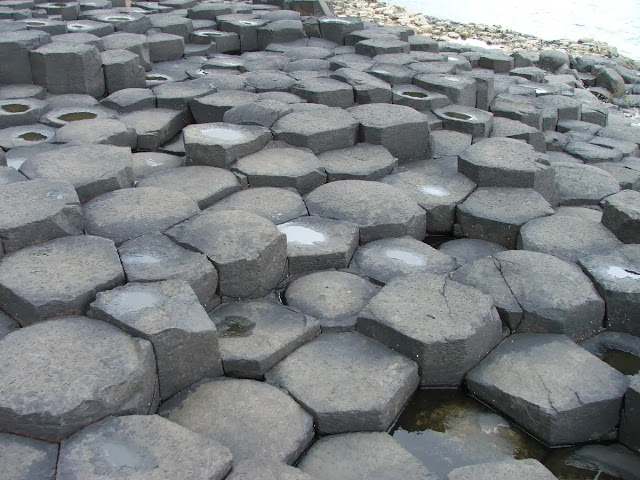Marston Marble: Fossiliferous Limestone
Marston Marble is a type of limestone found in Marston Magna, Somerset, England. This limestone is famous for containing abundant, well-preserved small ammonite fossils from the Jurassic Period, which makes it a highly decorative and sought-after material.
What is Marston Marble
Marston Marble is not actually a marble but a limestone, often referred to as 'Ammonite Marble' due to the presence of numerous small ammonites within it. It is a local concretionary horizon within the Charmouth Mudstone Formation, specifically found near the village of Marston Magna in Somerset, England.
Marston Marble is typically a dark grey or brown color, with the white or cream-colored ammonite fossils embedded throughout. The ammonites themselves can vary in size, from just a few millimeters to a few centimeters. When polished, the contrast between the dark matrix and the lighter-colored fossils is stunning.
 |
| Marston Marble: Fossiliferous Limestone |
Ammonites were a diverse group of extinct marine animals that lived in the oceans from the Devonian period, around 400 million years ago, until the end of the Cretaceous period, about 66 million years ago. They were cephalopods, related to modern-day squid and octopus, and are known for their distinctive spiral-shaped shells. Ammonites were widespread and diverse creatures, and their fossils provide valuable information about the Earth’s geological history and the evolution of marine life.
Key characteristics of Marston Marble
Color: The fossilized ammonites are typically a creamy white or light beige, while the surrounding matrix is a dark gray or brownish-black.
Hardness: On the Mohs scale of mineral hardness, Marston Marble has a hardness of 3 to 4, which is relatively soft compared to other stones.
Texture: Marston Marble has a smooth, polished texture when finished. However, the presence of the fossilized ammonites can create a slightly bumpy or uneven surface.
Mineral Composition: Marston Marble is not a fossilized limestone containing ammonites. The primary minerals are: Calcite, Clay minerals, Quartz, and Iron oxide.
 |
| Marston Marble from Marston Magna, Somerset, England Photo by: fossil_birdy |
How Marston Marble Was Formed?
Marston marble formed through a series of geological processes involving ancient seashells and mineral transformation. Here's how it happened:
- Formation from Ammonites: Marston marble contains fossilized ammonites, particularly Promicroceras Spath, Xipheroceras Buckman and Asteroceras Hyatt, which lived around 200 to 174.1 million years ago during the Jurassic Period.
- Building Up Layers: Ammonites accumulated on the seabed over time, forming a layer of calcareous mud. Calcareous mud contains calcium carbonate, a common component of seashells.
- Petrification (Lithification): The calcareous mud underwent lithification, a process where it hardened into rock. This process typically involves the cementation of loose particles by dissolved minerals, which over time turn into solid rock.
- Agatization: After lithification, the ammonite fossils embedded in limestone underwent agatization. This process involves silica-rich fluids infiltrating the limestone. These fluids dissolve some minerals and deposit chalcedony (a form of quartz) in the voids left by the dissolved minerals. In Marston marble, this process selectively filled the ammonite fossils with chalcedony while leaving the surrounding limestone largely unaltered.
 |
| Marston Marble: Fossiliferous Limestone |
Marston Marble Uses
Marston Marble is a versatile material with various uses, including:
- Jewelry making: Cut and polished into cabochons, Marston Marble is used in pendants, rings, earrings, and other jewelry pieces.
- Decorative carvings: Marston Marble is carved into figurines, bookends, paperweights, and other ornamental objects.
- Inlays: Thin slices of Marston Marble are used to create intricate inlays in furniture, boxes, and other decorative items.
 |
| Rough Marston Marble ammonite |
Marston Marble FAQs
Where is Marston Marble found?
Marston Marble is primarily found in the coastal cliffs and quarries near Lyme Regis and Charmouth in Dorset, England.
Is Marston Marble a real marble?
Geologically, no. True marbles are metamorphic rocks formed from limestone. Marston Marble is a sedimentary rock with fossils.
What is the age of Marston Marble?
Marston Marble dates back to the early Jurassic epoch, roughly 200 to 174.1 million years ago.
What other fossils besides ammonites are found in Marston Marble?
Ammonites are the most common fossils found in Marston Marble, but other marine organisms such as belemnites (cephalopods), bivalves (clams), brachiopods, gastropods (snails), fish, marine reptiles (like ichthyosaurs and plesiosaurs), and various other invertebrates.
Is Marston Marble rare?
Marston Marble itself may not be rare, but well-preserved specimens with intact fossils can be less common and therefore more valuable to collectors and researchers.
Read also:Septarian Concretion: What Is Septarian Concretion
How Limestone is Formed, Where Does it Form?



%20(1).webp)




